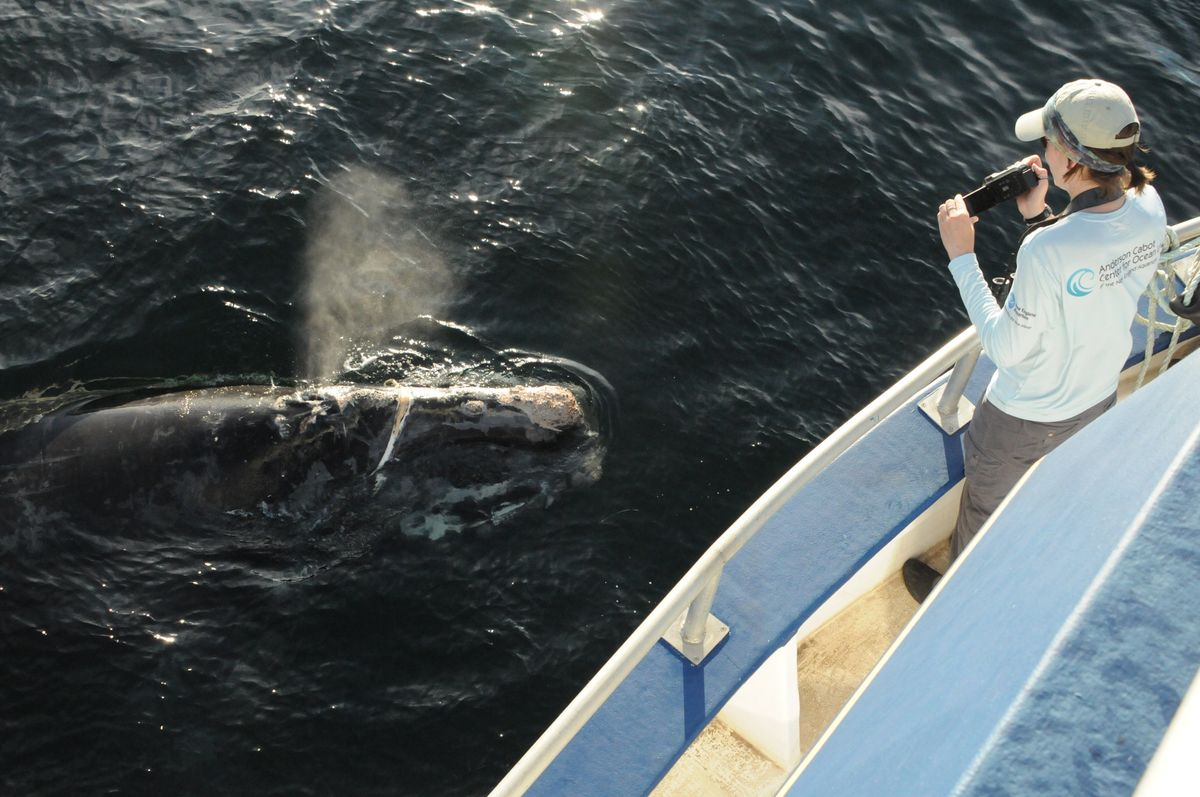

Researchers Collaborate On Right Whale Survey in Canada
September 29, 2018
Source: The great whale watch: How a data blitz put the plight of endangered animals into sharper relief - The Globe and Mail

Mariana Hagbloom of the New England Aquarium observes a right whale during a research trip in the Gulf of St. Lawrence this summer
Credit: Whale, Particle and Fish Lab, Dalhousie University
Researchers from multiple agencies and multiple countries have collaborated on a large survey of North Atlantic right whales in Canada with the support of the Canadian military. There has been an increase of North Atlantic right whales in Canadian waters, and a large increase in deaths of these whales, especially in the Gulf of St. Lawrence. It was believed that they started coming to the area in search of food and further research has now proven that. Researchers from Dalhousie University have been studying an area between New Brunswick and Prince Edward Island called the Orpheline Trough. Conditions there are nearly identical to the best right whale habitat in the Gulf of Maine, including the presence of copepods - their main source of food. It's not yet known whether right whales have always used the trough but it is clear that it has now become crucial to their survival. "Within a single year we’ve documented more than one-quarter of the population using that area," said Kim Davies, a research associate at Dalhousie who has been studying the whales’ shifting habits.
The Globe and Mail article stated that the new collaborative research conducted in late July of this year "identified about 30 to 40 whales from plane and survey boat, while two autonomous gliders were underwater recording whale calls. Overhead, a passing satellite simultaneously measured ocean conditions. Finally, and most crucially, were the 32 sonobuoys – sensitive underwater microphones that are designed to hunt for submarines – that the Canadian air force deployed in the same location from a C-140 maritime patrol aircraft. Together, the academic, government and military contributions added up to an unprecedented snapshot of right-whale activity across 1,500 square kilometres of open ocean." That's approximately 932 square miles and became "the largest and most multilayered data-gathering effort ever attempted with right whales". The agencies and groups involved included Fisheries and Oceans Canada (DFO), the U.S. National Oceanic and Atmospheric Administration, the New England Aquarium in Boston and the Canadian Whale Institute, a non-profit organization based in New Brunswick.
We strongly support research in the Gulf of St. Lawrence, especially when it is done in a collaborative manner like this so that as much information as possible is gained and so that many experts from various fields can contribute their knowledge and skills. However, we always caution that new research alone will not save these whales and will only help protect them if the findings are used to implement new protections. And, although we believe that the government could use the research to add better safety measures - especially since the Canadian government did institute protections for them this year that were stronger than ones in years past - the bottom line is that we already know what is harming these whales and what needs to be done to put a complete stop to whale deaths at the hands of humans. Human industries, mainly the fishing and shipping industries, are the ones killing these whales and have been doing so for a long time. Now that North Atlantic right whales are expanding their range to find food - thanks to climate change caused by humans - they are moving into areas that humans have already been unnaturally exploiting so these whales are now being forced to swim amongst even more traps, nets and large ships that present major threats to their individual safety and to the long-term existence of their population. Research can inform short-term protections such as fishing area closures and speed restrictions for ships but as long as humans continue to believe the myth that the fishing and shipping industries can coexist peacefully with the whales that have lived in the oceans for millions of years then these whales are still at risk. We encourage everyone to check out our Facts section on our website to learn more about what is happening to these whales and to check out our Action section to find out how we can help these whales in our everyday lives.